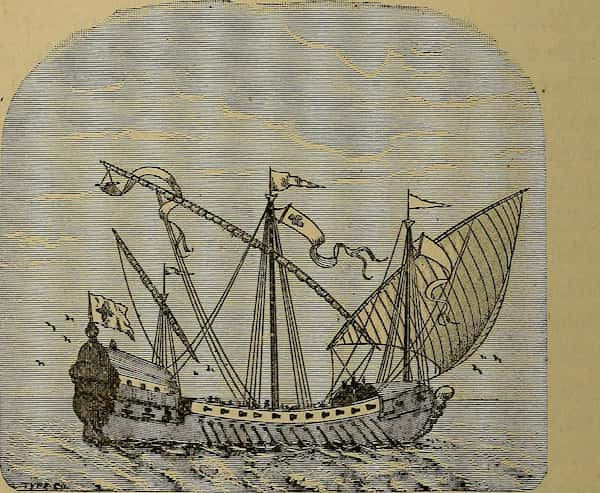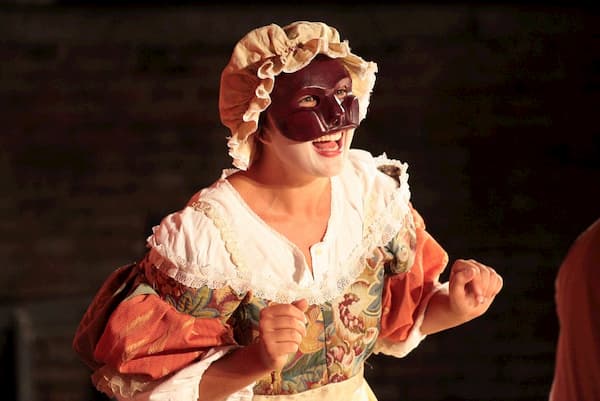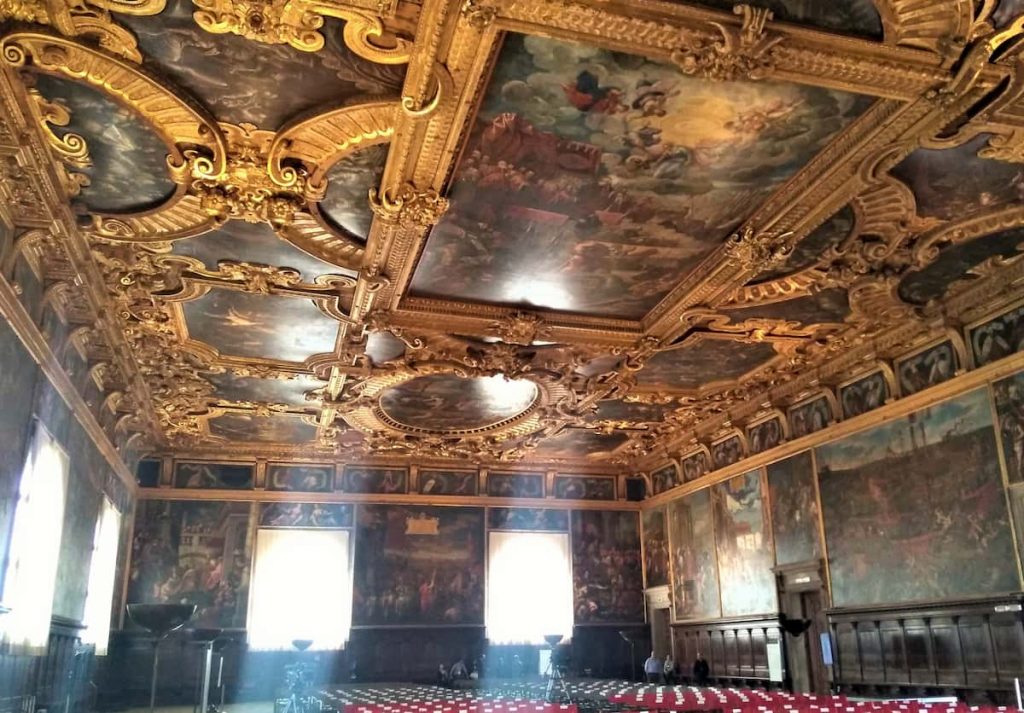Venice history is now approaching the beginning of the end. At the end of 1400 and the beginning of 1500, many new circumstances affected the Venetian Republic. These new issues made her move all her power and territory slightly toward the west. Venice still was a major player in the eastern Mediterranean and had been so for several hundred years, but new challenges awaited.
Venice’s dominant grip on trading with the Orient, and China, had brought unimaginable wealth and power. But from the 15th century three circumstances slowly changed all that:
- The Plague.
- The rise of the Ottoman Empire.
- In 1498 Vasco da Gama reached India and opened for trading to the Orient by sea.
The Plague.
The bubonic plague came to Venice in 1348. After that, it struck the city 68 times until 1798 when the last ship, a Spanish brig, entered and was quarantined. The Plague brought death, pain, and immense grief. But it also put enormous stress on the economic reality of the city.

The trading vessels had to stop for 40 days before they were let into Venice. That alone, costed gold. The soldiers died, which led to a weaker military force, the workers died which made the manufacturing facilities and the Arsenale difficult to sustain, the sailors died and the ships couldn’t travel. These were hard times in the history of Venice and they had an incredible impact on the republic. And Venice suffered more than others because she traded mostly with the orient.
Obviously, it wasn’t Plague every year, but when the pestilence came, all normal life stopped. People couldn’t really carry out anything, they were all busy just surviving. And the years after, the ones that were left were busy still trying to survive without their loved ones, and without all the people doing the important stuff, the stuff that makes a city function.
The rise of the Ottoman Empire.
Already in 1402, the Ottomans had conquered most of today’s Turkey. Only Constantinople resisted the siege. At that time, the Ottomans were attacked from the east by the Timurid Empire and this forced them to concentrate their military to the eastern front. But in 1453 they came back and took the city.
And now Venice had an impressively powerful neighbor, one who wasn’t as easy to tie bonds with as the Byzantine Empire had been. By the mid 15th century, the Ottomans held Greek and Turkey. That was land along the former Venetian trading routes, and it made the eastern Mediterranean much more hostile. By the beginning of the 16th century, through expansive foreign politics and many military victories, the Turks had taken all of the eastern shores. Venice was now more or less completely cut off from the prosperous Silk road.
In 1498 Vasco da Gama reached India.

The loss of the eastern shores and losing access to the oriental trade routes came contemporary with the Portuguese discovering the sea route to India. Going by sea was dangerous and costly. But instead of loading the spices and the silk on Camels and walk, you could now fill a ship with tons of the goodies and let the wind bring it back. And you bought directly from the source instead of having to split the earnings between all the various transporters and tax- and customs- authorities.
It also meant that anybody could participate. Before that, Venice had monopolized the trade and they were the only ones who had the knowledge and the connections to find the right men, the right merchandise at the right time and price. Now, all that was free for the taking. And new trading companies started to pop up all over Europe.
These facts made the economy of the republic more vulnerable. It wasn’t as easy to earn gold as it had been. Remember that in the history of Venice, money and wealth were the foundation on which she stood.
Land-campaigns
Venice wouldn’t have been Venice if she hadn’t come up with a solution. And the solution was to conquer land to compensate for the decline in income. What they lost in the east, they gained in the west. They just had to learn to fight land-battles too. Now, in those days the difference between sea-battles and land-battles wasn’t all that great. Even at sea, the fighting was mostly man to man with spears and swords. Anyway, the Venetians proved themselves as powerful on land as on the seas and at the end of 1400, they had conquered a big part of what is now northern Italy. They were as far west as to the outskirts of Milan.
When they went south they bumped into problems though. In trying to take control over Romagna, Pope Julius II, being from Genua, the previous major opponent for the control of the eastern trade routes, initiated a coalition to once and for all destroy Venice.
The League of Cambrai included France, The Holy Roman Empire, Spain, and the papal State. Together with a few Italian Duchies, this was more or less all of western Europe against the republic of Venice. The result of the war was that Venice lost its territory and it lost its fleet in the battle of Polesella. Immediately after they regained almost all of it as the League couldn’t keep united. The political intrigues of Venice had paid off.
Wars were fought almost on a daily basis and Venice won and lost evenly. What’s interesting with the League of Cambrai is that at this time Venice was such a dominant power that all the biggest and most powerful nations in Europe came together to try to stop her.
Venice History – The Battle of Lepanto
The respect and fear of Venice as a military superpower became even more obvious in the battle of Lepanto 1571. Now, the former enemies had established an alliance to stop the Ottoman expansion. France, Spain, The Holy Roman Empire, and The papal state had all come together with Venice to fight the Ottoman fleet.

The battle on October 7, 1571, was one of the biggest naval battles of all time. The Allied forces had 212 ships, more than half of which were Venetian. The Ottomans had 278. They were all divided into three groups, each opposing their respective counterpart. One to the north, one in the middle, and one to the south. Even though the Turks had more ships, The Christians had more cannons, 1815 against 750.
The Galleass. A new way of sea battle was born.
The Arsenale in Venice had ìnvented a new type of ship, the Galleass. And this made a huge difference. Every group had two of these Galleasses in front of the line of Galleys. The huge Galleasses were sailing alone. As they resembled very big trading ships, the Ottomans didn’t think of them as a significant threat. But as the Turkish Galleys passed them to reach the many Galleys sailing behind, they opened fire from a full line of lateral cannons. This was a new type of sea battle and the Ottomans weren’t prepared for it. As they tried to turn back they were still in the line of the broad-sides and these Galleasses, a total of 6, made an enormous amount of damage.
In the end, the Christians had won a decisive victory, and some say that this was the turning point for the Ottoman Empire. For Venice, the turning point wasn’t all that obvious though. They had stopped the Ottomans from expanding further west, but the trade routes to the east were still in the hands of the Turks. For Venice, this meant hard times to rebuild the trade. The Turks, with their well-organized military structure, and their wealth, built an entirely new fleet in only 6 months.
Definitely losing the eastern Mediterranean.
Venice continued to fight the Ottomans until the beginning of 1700, but Venice was in decline. In 1571, the summer before the Battle of Lepanto, they lost Cyprus, and they lost Crete in 1669. The southern parts of Greece were in Ottoman hands from the beginning of 1500. They were partially retaken at the end of 1600 but lost again at the beginning of 1700. at this time, though, both the Ottomans and Venice had lost their military dominance in the eastern Mediterranean.
Venice History – The world capital of Art and Decadence.

The republic had a completely new career up the sleeve, though. The extreme wealth that Venice had gained in the previous centuries created new opportunities. The luxury in the city had no equal in any other part of Europe. The Palaces, cathedrals, and theaters were built side by side, and along the Grand Canal, the Gondolas and other embellished ships sailed up and down as pearls on the Queen’s necklace.
Under the Doge Pasquale Cicogna in 1587, the Banco di Piazza (Bank in the Square), was founded. This was the first public bank in the world, and it was financed with state resources.
Venice had a tradition of neutrality and acceptance and tolerance toward others. As a consequence of the religious wars in Europe, many Protestants found safe heaven in Venice. So did Jews, who were generally very oppressed in the rest of Europe. As well as religious outcasts, Venice welcomed all kinds of Artists, sculptures, painters, and musicians. And so it became an artistic core, from which beauty radiated in all directions all over Europe.
Theater and Art.

In the 18th century, there were more than 20 theatres in Venice. Opera, an Art-form born in Italy and based upon religious theater and Comedia dell’Arte, became immensely popular among the Venetians. The world’s first theatres outside of the church and the courts, where anybody could simply buy a ticket and have access, were built in Venice. The theatres in those days weren’t only scenes for music and theatrical performances, but also for gaming, drinking, and even prostitution. And this contributed to making Venice a reputable candidate as a preferred destination for politicians, businessmen, and anybody with money.
The list of Venetian painters and sculptures can be made long. Names as Giovanni Bellini (1430 – 1516), Tiziano (1488 – 1576), Tintoretto (1518 – 1594), Veronese (1528 – 1588), Tiepolo (1696 – 1770), and Canaletto (1697 – 1768) all had a very important impact on Art all over Europe for centuries to come.
About the music…
Venice even gave a name to one of the most important trends and styles in the history of music… Scuola Veneziana, the Venetian school. These composers, of which the most famous is perhaps Claudio Monteverdi, ended the Renaissance and opened the doors to Baroque music and musicians like Bach and Händel who would follow in their footprints.
The Venetian composer Antonio Vivaldi was contemporary with J.S. Bach and at the time his equal in fame and artistic splendor. He’s most famous for his four Concerts, Le Quattro Stagioni, the four seasons.
The reason why there were so many artists in the 16th and 17th centuries was of course that they could find employment. Most other cities in Europe, even the big ones, had one lord, one Prince who engaged the musicians and the sculptors. In Venice there were lots of nobles with lots of money, there were theatres with an eagre public, and there was the church. On top of that, Venice was full of other rich persons, burgers, business folk, and foreign traders. And there was the carnival and all kinds of other festivals that all cried out for show-biz. Venice was a hot spot, the place to be.
The History of Venice – The French Revolution

In 1789 something new happened in Paris, France. The normal, French, average, guy got fed up with him not having anything to eat while the King, Luis XVI lived in wealth and abundance… And the French Revolution changed the European map from one day to the other.
In 1796, the young General Napoleon Bonaparte led the French army into Italy. They took Milan and wared themselves towards the east against the Austrian Imperial forces. Venice was in some sense a bystander, although the fighting took place on Venetian ground. The republic, as usual, tried to keep out of the war with diplomacy and neutrality, but this was a completely new type of enemy. This time the real issue was simply the injustice within the system, the privileges of the nobles against the poverty of the people. And that is an enemy you can’t fight with weapons.
The End
The French marched on and in April 1797 they signed a peace treaty with the Austrians. Having them out of the way, they took Verona and although Venice still intended to stay neutral, the French moved further east until they had positioned their army on the land-side, at Marghera, and officially declared war.

At this point, Venice still had all the defense systems in the lagoon intact. They captured a French ship that together with two other ships tried to enter through the Lido straight. They had lots of lands and many strongholds on the Croatian shores, and they had the entire Adriatic fleet ready to strike. Even so, a decimated Major Council agreed to surrender on the 12th of May 1797. When the crowds got the news, they tried to take over the Townhall and fight for their freedom, but the police were sent in to stop them.
The roles were now inverted. Instead of the Nobles fighting the revolutionary French, with the workers and farmers, keeping their fists clenched in their pockets, welcoming the new ideas… The nobles now had surrendered, while the poor and suppressed wanted to fight the French to save the republic. They were brutally suppressed.
On May 15, 1797, the French army under General Napoleon Bonaparte entered the city. After 1100 years, the history of Venice came to an end. A simple paper with the Doge’s, Ludovico Manin, signet. And the Venetian Republic was no more.
